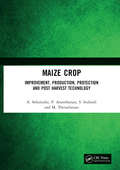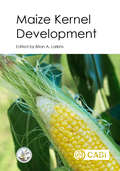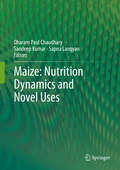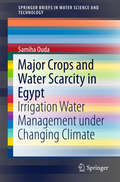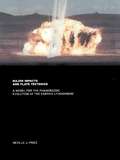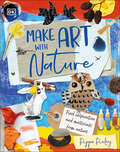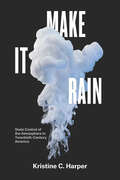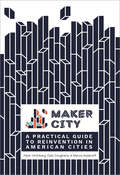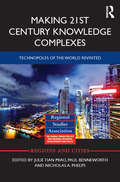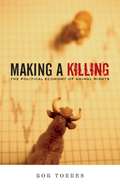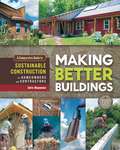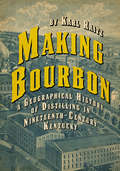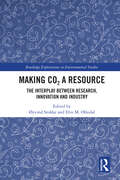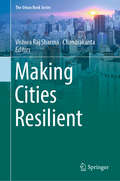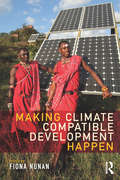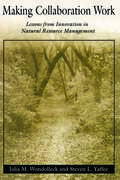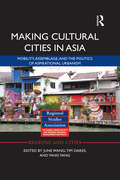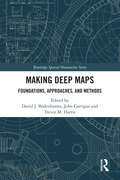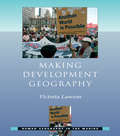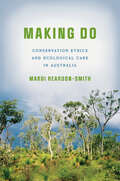- Table View
- List View
Maize Crop: Improvement, Production, Protection and Post Harvest Technology
by A. Solaimalai P. Anantharaju S. Irulandi M. TheradimaniMaize is one of the versatile emerging crops with wider adaptability under varied agro-climatic conditions. Globally, maize is known as queen of cereals because it has the highest genetic yield potential among the cereals. It is cultivated on nearly 150 m/ha in about 160 countries having wider diversity of soil, climate, biodiversity and management practices that contributes 36 % (782 m/t) inthe global grain production. The United States of America (USA) is the largest producer of maize contributes nearly 35 % of the total production in the world. It is the driver of the US economy. This book talks about the improvement, production, protection and post harvest technology of the maize crop. Note: T& F does not sell or distribute the Hardback in India, Pakistan, Nepal, Bhutan, Bangladesh and Sri Lanka.
Maize Kernel Development
by Bo Shen Alan Meyers Sherry Flint-Garcia Matthew Evans Philip Becraft Jim Birchler Ljudmilla Borisjuk Prem S. Chourey Joanne Dannenhoffer José Gutiérrez-Marcos Jeff Habben Curt Hannah Tracie Hennen-Bierwagen Gregorio Hueros Gwyneth Ingram Shawn Kaeppler Karen Koch Dr Brian A Larkins Fangfang Ma Don McCarty Jo Messing Keith Roesler Hardy Rolletschek Paolo Sabelli Jeff Schussler Bill Sheridan Rentao Song Erik Vollbrecht Thomas Widiez Yongrui Wu Ramin Yadegari Junpeng ZhanThis is an authoritative book that acts as a guide to understanding maize kernel development. Written by a team of experts, it covers topics spanning pre- and post-fertilization events, embryo and endosperm development, grain filling and maturation, and factors influencing crop yield. It explores the significance of maize and other cereal grains, existing hypotheses and research, and important gaps in our knowledge and how we might fill them. This is a valuable resource for researchers of maize and other cereals, and anyone working on basic or applied science in the fields of seed development, plant genetics, and crop physiology.
Maize: Nutrition Dynamics and Novel Uses
by Sandeep Kumar Dharam Paul Chaudhary Sapna LangyanMaize is a globally important crop mainly utilized as feed, food and raw material for diverse industrial applications. Among cereals, it occupies third place after rice and wheat and is a staple food for a large segment of population worldwide particularly in the Asian as well as African countries. This monogram discusses various aspects of nutritional quality of maize such as quality protein maize which has been considered as most significant discovery in enhancing nutritional quality of cereals in terms of increasing the concentration of essential amino acids. The biochemistry of starch which is an important industrial product of maize has been discussed in detail. Further, the role of maize oil which is highly regarded for human consumption as it reduces the blood cholesterol concentration has also been elaborated. Naturally, maize is a rich source of carotenoids such as beta-carotene, zeaxanthin, lutein, cryptoxanthin which have highly diverse health benefits ranging from maintaining normal vision to lowering of oxidative stress. The need for biofortification of maize for provitamin A carotenoids and their role in alleviating vision impairments have also been discussed. The effect of various biotic and abiotic stresses particularly carbon dioxide and temperature on quality has been discussed thoroughly. Many value-added products as well as fermented foods that have been produced from maize which is consumed in different forms worldwide are also discussed. The aspects related to the maize application as fodder and as a source of malting have also been covered concisely. Overall, the book provides complete information about various quality aspects of maize. The various stakeholders such as maize researchers, extension specialists, students, teachers as well as farmers will be immensely benefitted from this monogram.
Maize: Origin, Domestication, and Its Role in the Development of Culture
by Duccio Bonavia Javier Flores Espinoza Alexander GrobmanThis book examines one of the thorniest problems of ancient American archaeology: the origins and domestication of maize. Using a variety of scientific techniques, Duccio Bonavia explores the development of maize, its adaptation to varying climates, and its fundamental role in ancient American cultures. An appendix (by Alexander Grobman) provides the first ever comprehensive compilation of maize genetic data, correlating this data with the archaeological evidence presented throughout the book. This book provides a unique interpretation of questions of dating and evolution, supported by extensive data, following the spread of maize from South to North America, and eventually to Europe and beyond.
Major Crops and Water Scarcity in Egypt
by Samiha OudaThis book includes multi-disciplinary quantifications of the effect of climate change on water requirements of wheat, maize, rice and sugarcane. Furthermore, it provides on-farm management that faces water scarcity under current situation and under climate change. Changing cultivation method (raised beds instead of furrows or basins) or increasing irrigation application efficiency (sprinkler or drip systems instead of surface irrigation) can reduce the applied water. Irrigated agriculture, although profitable, it endures wasteful use of valuable water resources. Taking into account the risk of climate change, developing countries like Egypt will highly suffer. Furthermore, the effect of intercropping (two crops use the applied water to one of them), and/or using crop rotations (arrange crops to reduce the applied water, increase water productivity and sustain soil fertility) on production and consumed irrigation water by crops were comprehensively analyzed.
Major Impacts and Plate Tectonics: A Model for the Phanerzoic Evolution of the Earth's Lithosphere
by Neville PriceNeville Price presents a major breakthrough in our understanding of the subject of plate tectonics in this new book. In this ambitious look at the importance of impacts of objects from space on the earth, he challenges the fundamentals of the theory on which geoscience has rested for the past 25 years. In the latter half of the 20th century
Make Art with Nature: Find Inspiration and Materials From Nature
by Pippa PixleyGet creative and make incredible pieces of art using rocks, wood, berries, flowers, and leaves.Learn how to pour paint onto a canvas, how to put pencil to paper and draw, how pieces of old paper can make a beautiful collage, and how different mediums can come together to create incredible prints, all with artist Pippa Pixley. Become inspired as Pippa takes you into the outdoors and shows you a wide range of artistic techniques, from understanding basic color theory, to creating texture, movement, and fluidity in your own work. You'll soon be able to turn a blank canvas into a piece of art! Find out how the very earth beneath your feet can be used to make paints and pastels, and how flowers and vegetables can be repurposed to create inks. There is much to look forward to! Learn how to master different art forms, but also how to make your own art supplies. Simple-to-follow instructions, fun facts, tips, and tricks, as well as lively illustrations and photography will allow you the creativity to run wild!Art can be used to express our thoughts, ideas, and feelings. It can be a relaxation tool, a way to keep busy, a future career path, or just a hobby. But the magic of art is that it can come in many different forms! Perfect for budding artists or for those who just want a moment to enjoy the wonders of nature. Your curiosity and exploration will be unlocked, as this book has something for everyone!
Make It Rain: State Control of the Atmosphere in Twentieth-Century America
by Kristine C. HarperWeather control. Juxtaposing those two words is enough to raise eyebrows in a world where even the best weather models still fail to nail every forecast, and when the effects of climate change on sea level height, seasonal averages of weather phenomena, and biological behavior are being watched with interest by all, regardless of political or scientific persuasion. But between the late nineteenth century—when the United States first funded an attempt to “shock” rain out of clouds—and the late 1940s, rainmaking (as it had been known) became weather control. And then things got out of control. In Make It Rain, Kristine C. Harper tells the long and somewhat ludicrous history of state-funded attempts to manage, manipulate, and deploy the weather in America. Harper shows that governments from the federal to the local became helplessly captivated by the idea that weather control could promote agriculture, health, industrial output, and economic growth at home, or even be used as a military weapon and diplomatic tool abroad. Clear fog for landing aircraft? There’s a project for that. Gentle rain for strawberries? Let’s do it! Enhanced snowpacks for hydroelectric utilities? Check. The heyday of these weather control programs came during the Cold War, as the atmosphere came to be seen as something to be defended, weaponized, and manipulated. Yet Harper demonstrates that today there are clear implications for our attempts to solve the problems of climate change.
Make Prayers to the Raven: A Koyukon View of the Northern Forest
by Richard K. Nelson“A thorough and elegant account of the mystical connection between Native Americans and the natural world.” —Outside“This admirable reflection on the natural history of the Koyukon River drainage in Alaska is founded on knowledge the author gained as a student of the Koyukon culture, indigenous to that region. He presents these Athapascan views of the land—principally of its animals and Koyukon relationships with those creatures—together with a measured account of his own experiences and doubts. . . . For someone in search of a native American expression of 'ecology' and natural history, I can think of no better place to begin than with this work.” —Orion Nature Quarterly“Far from being a romantic attempt to pass on the spiritual lore of Native Americans for a quick fix by others, this is a very serious ethnographic study of some Alaskan Indians in the Northern Forest area. . . . [Nelson] has painstakingly regarded their views of earth, sky, water, mammals and every creeping thing that creepeth upon the earth. He does admire their love of nature and spirit. Those who see the world through his eyes using their eyes will likely come away with new respect for the boreal forest and those who live with it and in it, not against it.” —The Christian Century“Nelson's presentation also gives rich insights into the Koyukon subsistence cycle through the year and into the hardships of life in this northern region. The book is written with both brain and heart. . . . This book represents a landmark: never before has the integration of American Indians with their environment been so well spelled out.” —Journal of Forest History
Make Your Mark, Make a Difference: A Kid's Guide to Standing Up for People, Animals, and the Planet
by Joan Marie GalatTake the first steps into activism with this comprehensive middle grade guide that empowers readers to choose and become knowledgeable in a cause they are most passionate to reform, and to create meaningful change through learning what&’s already been accomplished—and what can still be done.Getting involved can be an overwhelming prospect, but this guide provides readers with tools to become informed and effective activists with an accessible approach offering hope and perspective. From Black Lives Matter and light pollution to climate change and healthcare equity for all, the book leads readers through an overview of issues, an essential human rights background, and stories of how other young activists tackle local, national, and international problems. Readers will discover a multitude of ways to build change and learn that every contribution matters.
Maker City: A Practical Guide for Reinventing American Cities
by Dale Dougherty Marcia Kadanoff Peter HirshbergThe Maker City Playbook is a comprehensive case studies and how-to information useful for city leaders, civic innovators, nonprofits, and others engaged in urban economic development. The Maker City Playbook is committed to going beyond stories to find patterns and discern promising practices to help city leaders make even more informed decisions.Maker City PlaybookChapter 1: Introduction and a Call to ActionChapter 2: The Maker movement and CitiesChapter 3: The Maker City as Open EcosystemChapter 4: Education and Learning in the Maker CityChapter 5: Workforce Development in the Maker CityChapter 6: Advanced Manufacturing and Supply Chain inside the Maker CityChapter 7: Real Estate Matters in the Maker CityChapter 8: Civic Engagement in the Maker CityChapter 9: The Future of the Maker CityMaker City Project is a collaboration between the Kauffman Foundation, the Gray Area for the Arts, and Maker Media.
Making 21st Century Knowledge Complexes: Technopoles of the world revisited (Regions and Cities)
by Paul Benneworth Nicholas A. Phelps Julie Tian MiaoThe world has changed profoundly since the publication of the influential book Technopoles of the World. As policy-makers and practitioners attempt to harness science, technology and innovation to create dynamic and vibrant cities many wonder how relevant Manuel Castells and Peter Hall's messages are today. Twenty years later, this book returns to their concepts and practices to update their message for the 21st century. Making 21st Century Knowledge Complexes: Technopoles of the World Revisited argues that the contemporary technopole concept encompasses three new dimensions. Firstly, building synergy between partners is vital for the success of complexes. Secondly, the correct governance arrangements are critical to balance competing interests inevitable in any science city project. Thirdly, new evaluation mechanisms are indispensable in allowing policy-makers to steer their long-term benefits. Through twelve case study chapters and a detailed comparative analysis, this book provides academics, policy-makers and practitioners with critical insights in understanding, managing and promoting today's high-technology urban complexes.
Making A Killing
by Bob TorresSuggest to the average leftist that animals should be part of broader liberation struggles and--once they stop laughing--you'll find yourself casually dismissed. With a focus on labor, property, and the life of commodities, Making a Killing contains key insights into the broad nature of domination, power, and hierarchy. It explores the intersections between human and animal oppressions in relation to the exploitative dynamics of capitalism. Combining nuts-and-bolts Marxist political economy, a pluralistic anarchist critique, as well as a searing assessment of the animal rights movement, Bob Torres challenges conventional anti-capitalist thinking and convincingly advocates for the abolition of animals in industry--and on the dinner plate.Making A Killing is sure to spark wide debate in the animal rights and anarchist movements for years to come.Table Of Contents:I Taking Equality SeriouslyII Chained CommoditiesIII Property, Violence, and the Roots of OppressionIV Animal Rights and WrongsV You Cannot Buy the RevolutionAdvance praise for Making A Killing"Bob Torres' Making a Killing draws a very straight line between capitalism and the oppressive system of animal agribusiness. Drawing from social anarchist theory, Torres provides a convincing argument that in order to fight animal exploitation, we must also fight capitalism and, in doing so, animal rights activists will need to reconsider their methods and redirect their focus. While his critiques of the animal rights movements' large organizations may not earn him friends in high places, such considerations are crucial to keeping the movement on track and for preventing stagnation.Making a Killing is an important work from a new voice in animal advocacy that will surely spark heated discussions amongst activists from all corners of the movement."--Ryan MacMichael, vegblog.org"In Making A Killing: The Political Economy of Animal Rights, Bob Torres takes an important and timely look at the animal rights movement, calling for a synthetic approach to all oppression, human and animal. His analytical framework draws together Marxism, social anarchist theory, and an abolitionist approach to animal rights to provide a timely social analysis that will no doubt have profound effects on the animal rights movement literature."--Gary L. FrancioneDistinguished Professor of Law, Rutgers University"Bob Torres's socioeconomic analysis of nonhuman animal use is a welcome and important addition to the understanding of human-nonhuman relations at the beginning of the 21st century. In particular, Making a Killing, makes vital a contribution to understanding the role of the property status of animals and the continuing strength of various welfarist positions on the ethics--and indeed the economics--of the human utilisation of other animals. Making a Killing will become required reading for social scientists and others interested in modern social movements and the socioeconomic forces that shape their activities and their claims-making."--Dr. Roger Yates, Lecturer in sociology at University College, Dublin, Republic of Ireland"This is the book I've been waiting for. Making A Killing is a rare and powerful example of first-rate scholarship, a searing critique, and lively declaration of the rights of animals and humans. You will walk away from this book with a clear understanding as to why social justice movements for people must take animal rights seriously, and vice versa. Bob Torres has forever deepened my thinking about these relationships."--David Naguib Pellow, vegetarian, animal rights and anti-racist activist, and Professor of Ethnic Studies, University of California, San Diego; and author of Garbage Wars: The Struggle for Environmental Justice in Chicago and Resisting Global Toxics: Transnational Movements for Environmental JusticeBob Torres is assistant professor of sociology at St. Lawrence University, received his PhD from Cornell, and is co-author of Vegan Freak: Being Vegan in a Non-Vegan World. His writings have appeared in Critical Sociology, The Journal of Latinos and Education...
Making Better Buildings
by Chris Magwood Jen FeiginMuch has been written about the individual components of sustainable building, but how do you bring it all together into a well-designed whole? Drawing on extensive hands-on experience, Making Better Buildings systematically describes the real-world implications of the most popular green and natural building materials and techniques, objectively presenting the pros, cons and overall viability of each. An indispensable resource.
Making Bourbon: A Geographical History of Distilling in Nineteenth-Century Kentucky
by Karl Raitz“Raitz examines the rich story of distilling in its Kentucky heartland and traces its maturation from a local craft to an enduring industry.” —William Wyckoff, author of How to Read the American WestWhile other industries chase after the new and improved, bourbon makers celebrate traditions that hearken back to an authentic frontier craft. Distillers enshrine local history in their branding and time-tested recipes, and rightfully so. Kentucky’s unique geography shaped the whiskeys its settlers produced, and for more than two centuries, distilling bourbon fundamentally altered every aspect of Kentucky’s landscape and culture.Making Bourbon: A Geographical History of Distilling in Nineteenth-Century Kentucky illuminates how the specific geography, culture, and ecology of the Bluegrass converged and gave birth to Kentucky’s favorite barrel-aged whiskey. Expanding on his fall 2019 release Bourbon’s Backroads, Karl Raitz delivers a more nuanced discussion of bourbon’s evolution by contrasting the fates of two distilleries in Scott and Nelson Counties. In the nineteenth century, distilling changed from an artisanal craft practiced by farmers and millers to a large-scale mechanized industry. The resulting infrastructure—farms, mills, turnpikes, railroads, steamboats, lumberyards, and cooperage shops—left its permanent mark on the land and traditions of the commonwealth. Today, multinational brands emphasize and even construct this local heritage. This unique interdisciplinary study uncovers the complex history poured into every glass of bourbon.“A gem. The depth of Raitz’s research and the breadth of his analysis have produced a masterful telling of the shift from craft to industrial distilling. And in telling us the story of bourbon, Raitz also makes a terrific contribution to our understanding of America's nineteenth-century economy.” —David E. Hamilton, author of From New Day to New Deal
Making CO2 a Resource: The Interplay Between Research, Innovation and Industry (Routledge Explorations in Environmental Studies)
by Elin M. Oftedal Øyvind StokkeThis interdisciplinary book explores how CO2 can become a resource instead of a waste and, as such, be a tool to meet one of the grandest challenges humanity is facing: climate change.Drawing on a Norwegian narrative that has significance for a global audience, Øyvind Stokke and Elin Oftedal introduce in-depth, multi-perspective analyses of a sustainable innovation research experiment in industrial carbon capture and utilisation technologies. Building on extensive literature within marine sciences, sustainability research, and environmental philosophy and ethics, this book documents how a misplaced resource like CO2 can become valuable within a circular economy in its own right, while at the same time meeting the challenge of food security in a world where food production is increasingly under pressure. The book is diverse in scope and includes chapters on how to reduce the environmental footprint of aquaculture by replacing wild fish and soy from the Amazon, how to optimise the monitoring of aquatic environments via smart technologies, and how to replace materials otherwise sourced from natural environments. The authors also analyse the pivotal role of the university in driving innovation and entrepreneurship, the pitfalls of different carbon technologies, and explore how the link between petroleum dependence and CO2 emissions has been addressed in Norway specifically.Making CO2 a Resource will be of great interest to students and scholars of climate change, environmental ethics, environmental philosophy, sustainable business and innovation, and sustainable development more broadly.
Making Cities Resilient (The Urban Book Series)
by Chandrakanta Vishwa Raj SharmaAs the world has transformed, so have cities. Today, cities are home to 54 percent of the world’s population, and by the middle of this century that figure will likely rise to 66 percent. According to the United Nations (UN) Habitat I (1972), Habitat II (1996) and Habitat III (2016) summits, cities are facing many serious challenges, including growing inequality, security concerns and the worsening impacts of climate change. Uncontrolled urbanization has led to many problems (haphazard growth of areas, emergence of slums, inadequate water and power supply, poor sanitation, shortage of transport and other civic amenities, shrinking green spaces, pollution, crime, and urban disaster risks such as fire, flood, road and industrial accidents, etc.). Worldwide, communities at the international, national and local level are continuously working to improve human habitats. In order to make our planet more sustainable, the UN has moved from the Millennium Development Goals (MDG) to the Sustainable Development Goals (SDG). Among the latter, the aim of SDG 11 is to “…make cities and human settlements inclusive, safe, resilient and sustainable.” In light of these challenges, various terms have emerged to help understand urban issues. Visualizing the problem, the United Nations program “Making Cities Resilient” is focused on mitigating the disaster risk in urban areas. This book analyzes terms such as: sustainable, resilient, livable, inclusive, smart and world class city, which have emerged in the process of combating urban challenges in today’s world. The book addresses emerging concepts for cities, challenges and potentials, urban environments, health and planning/policies. Covering 14 large cities in India, as well as case studies from Japan, Singapore, Thailand, Malaysia, Poland and Sweden, it provides a regional dimension to and micro-level perspective on urban issues.
Making Climate Compatible Development Happen
by Fiona NunanMaking Climate Compatible Development Happen introduces readers to the concept of climate compatible development (CCD) through exploring what it might look like, how it could be achieved in practice and identifying challenges and dilemmas raised by CCD. The book brings together research that explores the assumptions underlying CCD and applies the concept in a range of geographic and sectoral settings. The volume makes a significant contribution to the theorisation and evidence-base for how development efforts can be made more climate resilient and with lower greenhouse gas emissions than a ‘business as usual’ approach. It provides critical reflections on the vision and conceptualisation of CCD, exploring how to encourage it, and what trade-offs and challenges may be encountered. The contributions discuss the feasibility of achieving CCD, mechanisms that may support progress towards it, challenges that may be experienced and the roles of, and impacts on, different stakeholder groups. Following a critical reflection on the concept of CCD, the potential nature of, and barriers to, CCD, it is examined in relation to agriculture, renewable energy, forestry, pastoralism, coastal areas and fisheries, with case studies taken from countries including Ghana, India, Kenya, Mongolia, Mozambique and Peru. The book provides a valuable cross-sectoral and international critical reflection on the theory and practice of CCD, and will be a resource for postgraduates, established scholars and undergraduates from any social science discipline, policymakers and practitioners studying or working on areas related to the interface between environment (climate change) and international development.
Making Climate Forecasts Matter
by National Research CouncilEl Nino has been with us for centuries, but now we can forcast it, and thus can prepare far in advance for the extreme climatic events it brings. The emerging ability to forecast climate may be of tremendous value to humanity if we learn how to use the information well.How does society cope with seasonal-to-interannual climatic variations? How have climate forecasts been used--and how useful have they been? What kinds of forecast information are needed? Who is likely to benefit from forecasting skill? What are the benefits of better forecasting?This book reviews what we know about these and other questions and identifies research directions toward more useful seasonal-to-interannual climate forecasts. In approaching their recommendations, the panel explores: Vulnerability of human activities to climate.State of the science of climate forecasting.How societies coevolved with their climates and cope with variations in climate.How climate information should be disseminated to achieve the best response.How we can use forecasting to better manage the human consequences of climate change.
Making Collaboration Work: Lessons From Innovation In Natural Resource Management
by Julia M. Wondolleck Steven Lewis YaffeeAcross the United States, diverse groups are turning away from confrontation and toward collaboration in an attempt to tackle some of our nation's most intractable environmental problems. Government agencies, community groups, businesses, and private individuals have begun working together to solve common problems, resolve conflicts, and develop forward-thinking strategies for moving in a more sustainable direction.Making Collaboration Work examines those promising efforts. With a decade of research behind them, the authors offer an invaluable set of lessons on the role of collaboration in natural resource management and how to make it work. The book: explains why collaboration is an essential component of resource management describes barriers that must be understood and overcome presents eight themes that characterize successful efforts details the specific ways that groups can use those themes to achieve success provides advice on how to ensure accountability Drawing on lessons from nearly two hundred cases from around the country, the authors describe the experience in practical terms and offer specific advice for agencies and individuals interested in pursuing a collaborative approach. The images of success offered can provide ideas to those mired in traditional management styles and empower those seeking new approaches. While many of the examples involve natural resource professionals, the lessons hold true in a variety of public policy settings including public health, social services, and environmental protection, among others.Making Collaboration Work will be an invaluable source of ideas and inspiration for policy makers, managers and staff of government agencies and nongovernmental organizations, and community groups searching for more productive modes of interaction.
Making Cultural Cities in Asia: Mobility, assemblage, and the politics of aspirational urbanism (Regions and Cities)
by Yang Yang June Wang Tim OakesThis book examines the vast and largely uncharted world of cultural/creative city-making in Asia. It explores the establishment of policy models and practices against the backdrop of a globalizing world, and considers the dynamic relationship between powerful actors and resources that impact Asian cities. Making Cultural Cities in Asia approaches this dynamic process through the lens of assemblage: how the policy models of cultural/creative cities have been extracted from the flow of ideas, and how re-invented versions have been assembled, territorialized, and exported. This approach reveals a spectrum between globally circulating ideals on the one hand, and the place-based contexts and contingencies on the other. At one end of the spectrum, this book features chapters on policy mobility, in particular the political construction of the "web" of communication and the restructuring or rescaling of the state. At the other end, chapters examine the increasingly fragmented social forces, their changing roles in the process, and their negotiations, alignments, and resistances. This book will be of interest to researchers and policy-makers concerned with cultural and urban studies, creative industries and Asian studies.
Making Deep Maps: Foundations, Approaches, and Methods (Routledge Spatial Humanities Series)
by John Corrigan David J. Bodenhamer Trevor M. HarrisThis book explores how we create deep maps, delving into the development of methods and approaches that move beyond standard two-dimensional cartography. Deep mapping offers a more detailed exploration of the world we inhabit. Moving from concept to practice, this book addresses how we make deep maps. It explores what methods are available, what technologies and approaches are favorable when designing deep maps, and what lessons assist the practitioner during their construction. This book aims to create an open-ended way in which to understand complex problems through multiple perspectives, while providing a means to represent the physical properties of the real world and to respond to the needs of contemporary scholarship. With contributions from leading experts in the spatial humanities, chapters focus on the linked layers of quantitative and qualitative data, maps, photographs, images, and sound that offer a dynamic view of past and present worlds. This innovative book is the first to offer these insights on the construction of deep maps. It will be a key point of reference for students and scholars in the digital and spatial humanities, geographers, cartographers, and computer scientists who work on spatiality, sensory experience, and perceptual learning.
Making Development Geography (Human Geography in the Making)
by Victoria LawsonMaking Development Geography is a timely new book which introduces readers to the major themes and debates in development geography. It argues cogently that the field is engaged in an ongoing process of reinventing itself as critical development geography, and highlights issues such as identity, globalization, social movements and sexuality. Readers are guided through the key concepts and developments of the last 50 years, surveying the themes of Keynesianism, Marxism and post-colonialism. At the same time, each chapter uses international examples to discuss important contemporary issues so that the real-world applications of theory can be understood.This enlightening book offers a comprehensive introduction to the fundamental debates for anyone with an interest in development issues.
Making Development Sustainable: Redefining Institutions Policy And Economics
by Johan HolmbergMaking Development Sustainable is an integrated series of essays on the policies for sustainable development from one of the leading policy research institutes for environmental and development issues.
Making Do: Conservation Ethics and Ecological Care in Australia
by Mardi Reardon-SmithCape York is a remote and biodiverse peninsula in northeastern Australia that has been inhabited by Aboriginal communities for thousands of years. Since colonization, much of the peninsula has been used for large scale cattle farming. It is also a place of global significance as the site of multiple environmentally protected bioregions, with ongoing efforts to recognize them as UNESCO World Heritage Sites. Despite the very human role in shaping the landscape of Cape York, the region remains widely thought of as a "wilderness" to be conserved and protected. In this context, what counts as natural and native matters crucially—as does who gets to decide how species and people are categorized and, accordingly, how they are controlled. Based on long-term field research with Aboriginal traditional owners, settler-descended cattle herders, and park rangers, Making Do investigates complex ways in which people form, maintain, and transform relationships to changing environments. How do we know the places in which we live, and how do we care for them among the ruptures created by forces like climate change, settler colonialism, and structural inequalities? To address these questions, Mardi Reardon-Smith traces issues such as the history of land tenure changes, the identification and control of weeds and feral pigs, and wildfires and Aboriginal cultural burning. Mardi Reardon-Smith argues that caring for land, a sprawling, messy, and sometimes violent process, is not just about repair, restoration, or maintenance—rather, it is about bringing into being workable landscapes, livable worlds, and possible futures.
